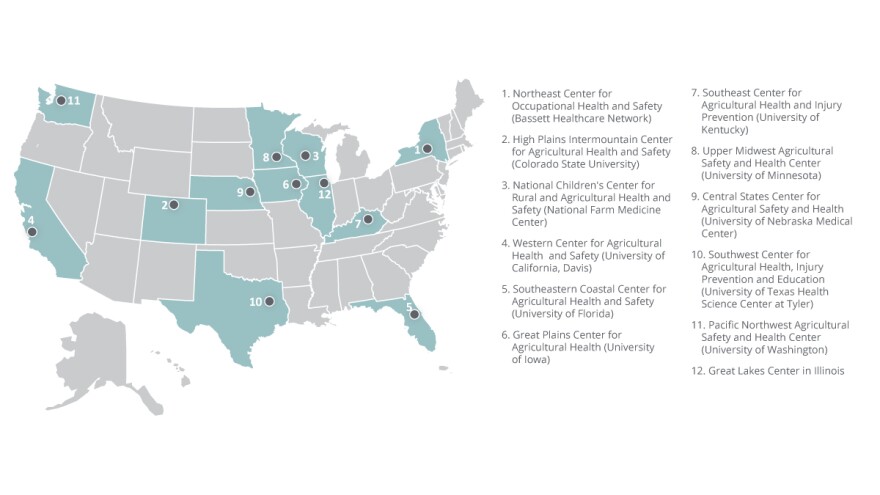A dozen research centers focused on improving safety and health conditions on American farms will lose federal funding this fall due to the Trump administration's cuts to federal health programs.
The National Institute for Occupational Safety and Health, or NIOSH, is one of the federal agencies that had hundreds of workers cut by Health and Human Services Secretary Robert F. Kennedy Jr. in April.
Some NIOSH programs, including those focused on miner safety and firefighter health risks, have had staff reinstated in order to keep operating. But federal officials have not brought back staff working with NIOSH's Centers for Agricultural Safety and Health, leaving multi-year studies and longstanding outreach programs without a clear path forward.
Jeff Bender, director of the Upper Midwest Agricultural Safety and Health Center at the University of Minnesota, said centers like his apply for NIOSH funding on a five-year cycle to study health concerns on farms in their region and provide education to producers. But the funding is distributed by NIOSH annually, meaning Bender's center will run out of money halfway through many of their approved projects.
As an example, he points to one study that is looking at how livestock exposure changes farmers' gut microbiomes and evaluating what biosecurity measures can help.
"Unfortunately, we've only sampled half of the farms, and we don't have any money to actually do the genomic work," Bender said.

NIOSH established the centers in 1990 to address the high rate of injury and death among farmers. Federal data shows agriculture, forestry and fishing workers still have the highest fatal injury rate, with 18.6 deaths per 100,000 workers in 2022 compared to 3.7 deaths per 100,000 workers across all industries.
Risto Rautiainen, director of the Central States Center for Agricultural Safety and Health at the University of Nebraska, has studied the economic impact of farm injuries. He found that a work-related injury costs a farmer an average of $15,000 in medical costs and lost work time. On a national level, he estimates the total loss from injuries is around $11.3 billion per year.
"It's quite a big burden on agricultural producers, and it hits you, not every year, but maybe every 10 years or so," Rautiainen said. "If you're not properly insured or if there are losses in work time and equipment costs, this is a real issue."
He worries that without centers like his providing safety training and education to farmers, the numbers of injuries and deaths will increase.
Farmer training programs at stake
On top of researching long-term safety and health issues, all of the NIOSH-funded centers provide assistance directly to farmers in their region.
Rautiainen's center runs a training program for staff at cattle feedyards on ways to reduce injuries, and has been involved in responding to new threats like providing personal protective equipment to dairy farms worried about bird flu.
Bender's center in Minnesota has been focused on supporting the mental health needs of farmers and their families, especially in rural areas with limited access to mental health care. His team also partnered with the National Farm Medicine Center in Wisconsin to develop a training program for rural fire departments on how to respond to farm emergencies.
Jerry Minor, chief of the Pittsville Fire Department in central Wisconsin, said his department has been working on the program since the 1980s.
"The type of call we get on a farm is usually a pretty high intensity type of call, you know entrapments, severe injuries, and we don't go to those calls very often," he said. "We've helped them develop programs on how to teach firefighters to enter silos and treat tractor rollovers."
Minor said the fire departments are also trained to work with local farms on reducing common hazards, like developing safe storage for farm chemicals or identifying what safety equipment is needed. More than 170 first responders in 16 states and 5 Canadian provinces have gone through the training, according to the program's website.
Minor said these programs are vital to both first responders and farm families, but they may not be able to continue if the centers lose their NIOSH funding.
"I'm very fearful of what might happen," he said. "I understand being fiscally responsible, but sometimes you've got to sit back and take a look at the bigger picture."

Future of ag safety research remains unclear
According to the Trump Administration's restructuring plan for the Department of Health and Human Services released in March, NIOSH programs will be consolidated under a newly formed "Administration for a Healthy America." But details of the new agency have yet to be released.
With funding set to run out this fall, Bender and his staff have been considering what comes next. He said that likely won't include research, which he said takes money and time. But he's hopeful they can continue their outreach efforts, especially for small and mid-size producers who aren't able to employ their own health and safety officer.
"Their margins are small," he said. "They can only spend so much money on personnel, and they don't often think about health and safety."
Rautiainen said his university has been urging federal lawmakers to bring back the program's funding in the next budget. His center has not laid off employees ahead of their grant ending in August, though he has unofficially suggested to some staff that they start looking for other jobs.
"I think there has been an intention (by the university) to keep at least core staff and faculty, even if the funding situation is not like it should be," he said. "If the decision will be reversed at some point, we still have key people in place to start again and continue the work that we have built over a couple decades."
This story was produced in partnership with Harvest Public Media, a collaboration of public media newsrooms in the Midwest and Great Plains. It reports on food systems, agriculture and rural issues.
Copyright 2025 KCUR 89.3







